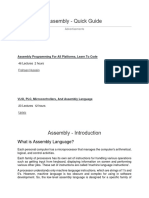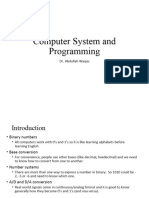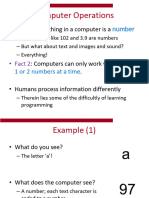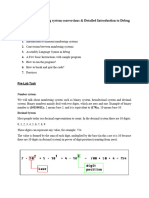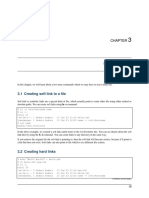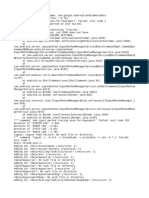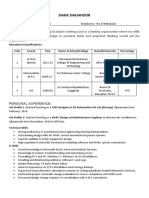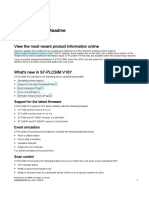6/15/24, 3:46 PM Assembly - Introduction
Assembly - Introduction
What is Assembly Language?
Each personal computer has a microprocessor that manages the computer's
arithmetical, logical, and control activities.
Each family of processors has its own set of instructions for handling various
operations such as getting input from keyboard, displaying information on screen
and performing various other jobs. These set of instructions are called 'machine
language instructions'.
A processor understands only machine language instructions, which are strings of 1's
and 0's. However, machine language is too obscure and complex for using in
software development. So, the low-level assembly language is designed for a specific
family of processors that represents various instructions in symbolic code and a
more understandable form.
Advantages of Assembly Language
Having an understanding of assembly language makes one aware of −
How programs interface with OS, processor, and BIOS;
How data is represented in memory and other external devices;
How the processor accesses and executes instruction;
How instructions access and process data;
How a program accesses external devices.
Other advantages of using assembly language are −
It requires less memory and execution time;
It allows hardware-specific complex jobs in an easier way;
It is suitable for time-critical jobs;
It is most suitable for writing interrupt service routines and other memory
resident programs.
https://www.tutorialspoint.com/assembly_programming/assembly_introduction.htm 1/6
�6/15/24, 3:46 PM Assembly - Introduction
Basic Features of PC Hardware
The main internal hardware of a PC consists of processor, memory, and registers.
Registers are processor components that hold data and address. To execute a
program, the system copies it from the external device into the internal memory.
The processor executes the program instructions.
The fundamental unit of computer storage is a bit; it could be ON (1) or OFF (0) and
a group of 8 related bits makes a byte on most of the modern computers.
So, the parity bit is used to make the number of bits in a byte odd. If the parity is
even, the system assumes that there had been a parity error (though rare), which
might have been caused due to hardware fault or electrical disturbance.
The processor supports the following data sizes −
Word: a 2-byte data item
Doubleword: a 4-byte (32 bit) data item
Quadword: an 8-byte (64 bit) data item
Paragraph: a 16-byte (128 bit) area
Kilobyte: 1024 bytes
Megabyte: 1,048,576 bytes
Binary Number System
Every number system uses positional notation, i.e., each position in which a digit is
written has a different positional value. Each position is power of the base, which is 2
for binary number system, and these powers begin at 0 and increase by 1.
The following table shows the positional values for an 8-bit binary number, where all
bits are set ON.
Bit value 1 1 1 1 1 1 1 1
Position value as a
128 64 32 16 8 4 2 1
power of base 2
Bit number 7 6 5 4 3 2 1 0
The value of a binary number is based on the presence of 1 bits and their positional
value. So, the value of a given binary number is −
https://www.tutorialspoint.com/assembly_programming/assembly_introduction.htm 2/6
�6/15/24, 3:46 PM Assembly - Introduction
1 + 2 + 4 + 8 +16 + 32 + 64 + 128 = 255
which is same as 28 - 1.
Hexadecimal Number System
Hexadecimal number system uses base 16. The digits in this system range from 0 to
15. By convention, the letters A through F is used to represent the hexadecimal
digits corresponding to decimal values 10 through 15.
Hexadecimal numbers in computing is used for abbreviating lengthy binary
representations. Basically, hexadecimal number system represents a binary data by
dividing each byte in half and expressing the value of each half-byte. The following
table provides the decimal, binary, and hexadecimal equivalents −
Decimal number Binary representation Hexadecimal representation
0 0 0
1 1 1
2 10 2
3 11 3
4 100 4
5 101 5
6 110 6
7 111 7
8 1000 8
9 1001 9
10 1010 A
11 1011 B
12 1100 C
13 1101 D
14 1110 E
https://www.tutorialspoint.com/assembly_programming/assembly_introduction.htm 3/6
�6/15/24, 3:46 PM Assembly - Introduction
15 1111 F
To convert a binary number to its hexadecimal equivalent, break it into groups of 4
consecutive groups each, starting from the right, and write those groups over the
corresponding digits of the hexadecimal number.
Example − Binary number 1000 1100 1101 0001 is equivalent to hexadecimal -
8CD1
To convert a hexadecimal number to binary, just write each hexadecimal digit into its
4-digit binary equivalent.
Example − Hexadecimal number FAD8 is equivalent to binary - 1111 1010 1101
1000
Binary Arithmetic
The following table illustrates four simple rules for binary addition −
(i) (ii) (iii) (iv)
0 1 1 1
+0 +0 +1 +1
=0 =1 =10 =11
Rules (iii) and (iv) show a carry of a 1-bit into the next left position.
Example
Decimal Binary
60 00111100
+42 00101010
102 01100110
A negative binary value is expressed in two's complement notation. According to
this rule, to convert a binary number to its negative value is to reverse its bit values
and add 1.
https://www.tutorialspoint.com/assembly_programming/assembly_introduction.htm 4/6
�6/15/24, 3:46 PM Assembly - Introduction
Example
Number 53 00110101
Reverse the bits 11001010
Add 1 00000001
Number -53 11001011
To subtract one value from another, convert the number being subtracted to two's
complement format and add the numbers.
Example
Subtract 42 from 53
Number 53 00110101
Number 42 00101010
Reverse the bits of 42 11010101
Add 1 00000001
Number -42 11010110
53 - 42 = 11 00001011
Overflow of the last 1 bit is lost.
Addressing Data in Memory
The process through which the processor controls the execution of instructions is
referred as the fetch-decode-execute cycle or the execution cycle. It consists of
three continuous steps −
Fetching the instruction from memory
Decoding or identifying the instruction
Executing the instruction
The processor may access one or more bytes of memory at a time. Let us consider a
hexadecimal number 0725H. This number will require two bytes of memory. The
high-order byte or most significant byte is 07 and the low-order byte is 25.
https://www.tutorialspoint.com/assembly_programming/assembly_introduction.htm 5/6
�6/15/24, 3:46 PM Assembly - Introduction
The processor stores data in reverse-byte sequence, i.e., a low-order byte is stored
in a low memory address and a high-order byte in high memory address. So, if the
processor brings the value 0725H from register to memory, it will transfer 25 first to
the lower memory address and 07 to the next memory address.
x: memory address
When the processor gets the numeric data from memory to register, it again
reverses the bytes. There are two kinds of memory addresses −
Absolute address - a direct reference of specific location.
Segment address (or offset) - starting address of a memory segment with the
offset value.
https://www.tutorialspoint.com/assembly_programming/assembly_introduction.htm 6/6






